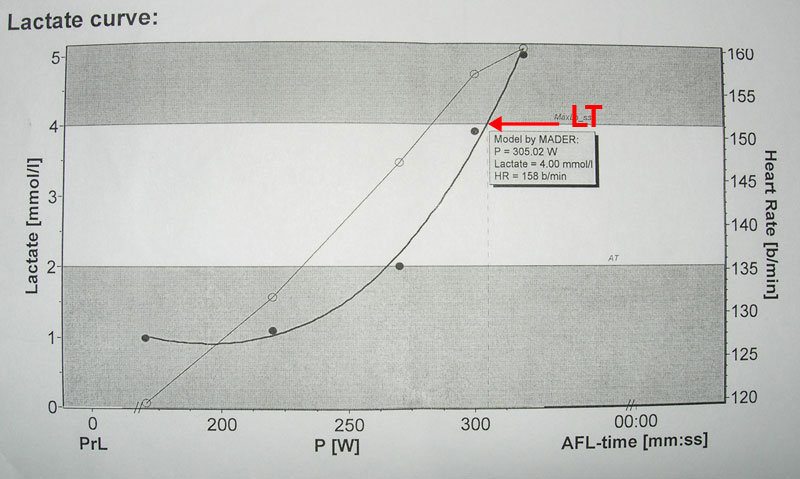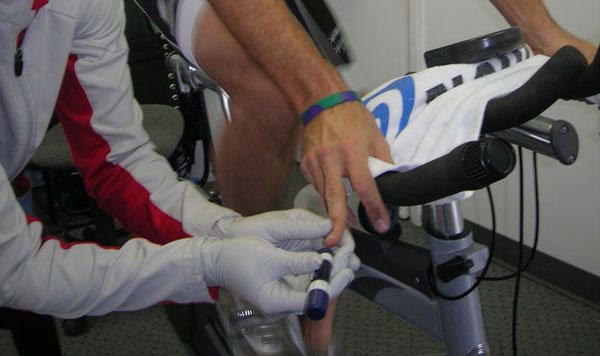I was recently a test subject for Coach Krista Schultz, MEd, CSCS to find out my power output at Lactate Threshold (LT).
What is lactate and why should you care about it?
First, let’s start with pyruvate.
Pyruvate is a byproduct (end result) of anaerobic glycolysis, which is the breakdown of glycogen (the body’s carbohydrate store) for energy by the muscles without requiring oxygen during the process.
Pyruvate then either:
- Enters the mitrochondria in a muscle’s cells for conversion to Acetyl-CoA and entry into the Kreb’s cycle – the process of oxidative phosphorylation or what we typically refer to as the “aerobic system” or
- Is converted to lactate, some of which is released in to our blood. Other muscles, the liver, the heart and other tissues can then utilize lactate as a fuel source.
At rest and at lower exercises intensities, the levels of lactate being produced are equal to the level of lactate being cleared away so the amount of lactate in the blood is fairly small and steady.
As exercise intensity increases, the “slower” aerobic system just can’t keep up with the intense demands placed on it so more and more pyruvate is converted to lactate, as the body draws more on the faster anaerobic glycolysis system to provide energy more quickly. The conversion of pyruvate to lactate helps “prime the pump” of anaerobic glycolysis.
As more lactate is produced than our body can clear away, our net blood lactate levels increase. Correspondingly, our blood is also becoming more acidic from the increased concentration of [H+] hydrogen ions (pH is going down). If your blood is too acidic, you’ll have to slow down until it becomes less acidic. If you’re familiar with the term “lactic acid burn” that’s what this is referring to.
What is a blood lactate test?
A blood lactate test measures the concentration of lactate in your blood drawn typically via pick on the end of your finger or ear lobe taken at increasing levels of exercise intensity (I was on a exercise bike for my test).
The purpose of the test is to determine lactate threshold (also refered to as “LT”). This particular test protocol defines lactate threshold as 4.0 mmol/L of lactate, which is a measurement of the concentration of lactate in the blood. Lactate threshold is essentially the point above which lactate begins to accumulate exponentially – in other words, lactate is produced much faster than it can be cleared away.
After a 15 minute warm up with easy pedaling, the test began. Starting at a moderate intensity, Krista increased the resistance on my bike every 3 minutes. At the end of each 3 minute period, she pricked my finger for a blood sample – just a drop – then used her lactate analyzer to measure my blood lactate levels while noting my both power level and heart rate. The test continued until I exceeded 4.0 mmol/L of lactate.
My test results are shown by the graph to the right.
 The dots on the chart represent sample lactate concentration data points taken every 3 minutes (y-axis) at corresponding power outputs (x-axis). The curved line is a polynomial curve mathematically fit to the data points.
The dots on the chart represent sample lactate concentration data points taken every 3 minutes (y-axis) at corresponding power outputs (x-axis). The curved line is a polynomial curve mathematically fit to the data points.
As you can see from the chart my blood lactate level was fairly constant for the first two data points (lactate produced was approximately equal to lactate consumed) then started to increase at the third point, which was about 275 Watts. At the third point (200W), I was just below the threshold of 4 mmol/L, which I then exceeded at the final point at 320 W.
Per the test, my LT is currently at 305W of power.
Why is knowing Lactate Threshold important to an endurance athlete?
Bassett and associates* believe that there are three major variables related to the maximal velocity that can be maintained in distance races:
- VO2 max (maximum amount of oxygen that the body can utilize during exercise)
- % VO2 max at Lactate Threshold
- Economy (measure of efficiency)
VO2 max is somewhat trainable, especially for an untrained individual, but not much increase can be expected for an athlete already highly endurance trained.
However, lactate threshold and economy are both very trainable.
As an endurance athlete, it’s helpful for you to know your lactate threshold today so that you know better structure your training in order to both:
- Go faster at lactate threshold
- Increase the amount of time your can sustain near lactate threshold intensity
When you test again in the future – after appropriate training of course, you can expect your power at lactate threshold to have increased, as well as your ability to sustain a higher training intensity for longer amount of time below lactate threshold. In other words, you’ll race faster.
Ultimately, as endurance athletes, we want to be able sustain as fast a speed as possible over the duration of our events. Knowing and understanding your lactate threshold is a powerful tool to help you do that more effectively.
Happy training,
David
P.S. Looking for a structured approach to your triathlon or run training? Be sure to check out our library of online training plans in TrainingPeaks including off-season plans, running races and triathlons.
—
 Coach David Glover, MS, CSCS has completed 28 IRONMAN distance triathlons, which includes two sub 9 hour finishes and winning Vineman Full twice. Now, David’s passion now is helping triathlete and other endurance athletes achieve their dreams through his online triathlon education and training company, ENDURANCEWORKS. David has an MS in Exercise Physiology and is certified as a coach by IRONMAN Triathlon, USA Triathlon and USA Cycling plus has his CSCS from NSCA. After six years of living, training and coaching in the triathlon mecca of Boulder, CO, David currently resides in Southern California.
Coach David Glover, MS, CSCS has completed 28 IRONMAN distance triathlons, which includes two sub 9 hour finishes and winning Vineman Full twice. Now, David’s passion now is helping triathlete and other endurance athletes achieve their dreams through his online triathlon education and training company, ENDURANCEWORKS. David has an MS in Exercise Physiology and is certified as a coach by IRONMAN Triathlon, USA Triathlon and USA Cycling plus has his CSCS from NSCA. After six years of living, training and coaching in the triathlon mecca of Boulder, CO, David currently resides in Southern California.


